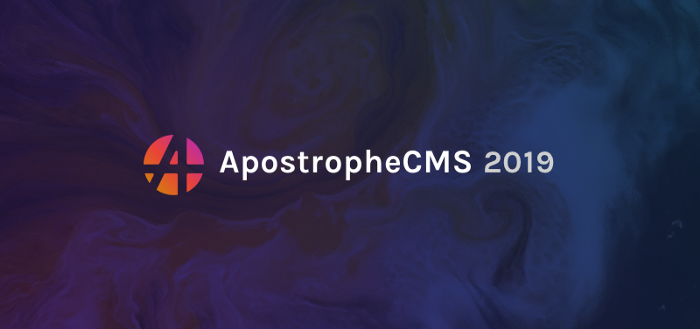If you’ve been following along with our sprint recap posts, you already know where our biggest focus is for this year: ApostropheCMS 3. We’ve been having fun digging into the weeds on rich text editor selection and plumbing the depths of Vue, but it’s time to bring the perspective up to a higher altitude and look out at the road ahead.
As a starting point, we would encourage everyone to review the 2019 Roadmap project on GitHub. In this post we’ll be reviewing what’s on that roadmap, including some milestones we’ve already hit for the year. Spoiler alert: there aren’t going to be any major surprises in this post, but hopefully a recap at this level helps bring some clarity around 3.0 to the wider Apostrophe community.
The demo site and what that really means
Let’s start with one of the things that’s not specifically related to 3.0, and something we’re especially excited about right now. If you didn’t see the announcement earlier this month — there is now a new and improved demo site for ApostropheCMS!

A brand new demo for ApostropheCMS
We’re really excited about what this demo allows us to do, specifically:
Show off more capabilities of ApostropheCMS to people who haven’t tried it before
Apostrophe does so much more than make it easy to edit and format text and images right on the page. In our old demo, we didn’t really show that, but the new demo brings in several core concepts around managing different content types and using dynamic custom widgets to quickly and easily build out beautiful pages.
Provide an example site to build a new set of getting started tutorials around
We’re not only actively working on improvements to the Apostrophe documentation site, we’re also planning a completely new set of tutorials using the demo as an example project. In these tutorials – coming later this Winter – you’ll be able to follow along with building the demo site, starting with an empty project and adding in content types, page templates, custom widgets, pieces filters, search, and doing all the configuration that happens in between. We hope that this helps new developers discover more quickly how powerful and easy it is to make a rich, responsive digital experience using Apostrophe.
Provide a fully featured boilerplate theme for developers who want to get a jump start on their Apostrophe projects
We’ve heard from the community that themes would be a significant improvement for Apostrophe. This is actually a key value provided by the new demo site. Using the apostrophe CLI and its boilerplate site generator tool, you can actually create your own project using the Open Museum project as a starting theme with a single command:
apostrophe create-project --boilerplate
https://github.com/apostrophecms/apostrophe-open-museum
my-new-websiteWe’ll be posting more details on how this works soon, and we see this first step as just the start of an ecosystem that can grow with contributions from the community and other demo alternatives we hope to roll out in the months to come. (We’re interested in hearing from you if this you want to learn more about how this works, so please reach out!).
When and how is 3.0 being delivered
Hopefully you’ve already been following along with our sprints (we’re always eager for questions, feedback, and participation via our open source channels). Through this process we’ve been able to answer a lot of questions about Apostrophe 3, like exactly how Vue will replace our admin UI and what technology will power the rich text editing experience. We’re now nearing the end of this process and looking ahead to the next quarter when we’ll bring more of a focus to building and delivering an alpha release of Apostrophe 3.
Apostrophe’s schema editor as a Vue component.

In this case, “alpha” means “it’s worth playing around with.” We don’t plan on putting any production projects on 3.0 until the second half of the year, when we’re projecting a 3.0-stable release. Along with that stable release you can look forward to a migration tool for your 2.x projects as well as an editor guide that will document the UI changes in Apostrophe 3 and help train any new end users on the tools.

Work in progress on the improved ApostropheCMS 3 UI.
Having a fully featured production-ready ApostropheCMS 3 means more than just upgrading the core apostrophe module, however. We’ve taken care to include the updating of critical plugins used in many production and enterprise websites built with Apostrophe, starting with apostrophe-workflow.
By the end of the year, we’re looking forward to upgrading the entire suite of of ApostropheCMS plugins to be fully compatible with the 3.0 release and take advantage of its improved UI and front-end JS practices.
What’s going on in Apostrophe 2.0 in 2019
Supporting all of the websites we build with Apostrophe at P’unk Avenue, as well as the support we provide for enterprise teams like Michelin and npm, means that we are constantly releasing new updates to Apostrophe 2.x.
Since mid-December we’ve already released persistent user notifications, improved support for editing deeply nested content, made UX enhancements to the editing experience, improved warnings for developers to avoid common pitfalls, implemented a better workflow experience for managing your page tree, and made many subtler fixes and improvements. We have no plans to reduce this velocity. All the more reason we are planning carefully on upgrade paths for 2.x projects and modules!
Of course, 2.x is an “LTS” (Long-Term Support) release. We have committed to supporting it at least through 2023, and have many clients of our own who will have no need to migrate in the short term.
Enhancements delivered in this way are sometimes reactive to short term projects and enterprise support customer needs, but can also break new ground. For instance, in the coming month we’re looking forward to delivering a new module that harnesses the Open Graph metadata most webpages already provide for social networks, in order to display an attractive preview in an Apostrophe widget… with a powerful twist: support for browsing content discovered via our apostrophe-headless module.
Onward
If you’ve made it this far, thanks for taking the time to read this and for your interest (and hopeful involvement) in ApostropheCMS and its community. We can’t wait to see all these improvements out there in the wild at the end of the year. If you’re interested in learning more, getting started with ApostropheCMS, or jumping into the community, you can join us on the forum or the chat. See you there!

